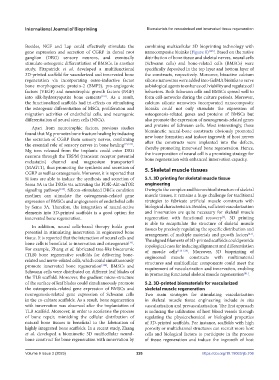Page 234 - IJB-9-3
P. 234
International Journal of Bioprinting Biomaterials for vascularized and innervated tissue regeneration
Besides, NGF and Lap could effectively stimulate the combining multicellular 3D bioprinting technology with
gene expression and secretion of CGRP in dorsal root nanocomposite bioinks (Figure 8) [125] . Based on the native
ganglion (DRG) sensory neurons, and eventually distribution of bone tissue and skeletal nerves, neural cells
stimulate osteogenic differentiation of BMSCs. In another (Schwann cells) and bone-related cells (BMSCs) were
study, Fitzpatrick et al. developed a multifunctional specifically deposited in the top layer and bottom layer of
3D-printed scaffold for vascularized and innervated bone the constructs, respectively. Moreover, bioactive calcium
regeneration via incorporating osteo-inductive factor silicate nanowires were added into GelMA bioinks to serve
bone morphogenetic protein-2 (BMP2), pro-angiogenic as biological agents to enhance cell viability and regulate cell
factors (VEGF) and neurotrophic growth factors (NGF) behaviors. Both Schwann cells and BMSCs spread well to
into silk-hydroxyapatite bone cements [121] . As a result, form cell-networks during the culture periods. Moreover,
the functionalized scaffolds had tri-effects on stimulating calcium silicate nanowires incorporated nanocomposite
the osteogenic differentiation of MSCs, proliferation and bioinks could not only stimulate the expression of
migration activities of endothelial cells, and neurogenic osteogenesis-related genes and proteins of BMSCs but
differentiation of neural stem cells (NSCs). also promote the expression of neurogenesis-related genes
Apart from neurotrophic factors, previous studies and proteins of Schwann cells. Most interestingly, these
found that Mg promotes bone fracture healing by inducing biomimetic neural-bone constructs obviously promoted
the secretion of CGRP from sensory nerves, confirming new bone formation and induce ingrowth of host nerves
the essential role of sensory nerves in bone healing [13,122] . after the constructs were implanted into the defects,
Mg ions released from the implants could enter DRG thereby promoting innervated bone regeneration. Hence,
neurons through the TRPM (transient receptor potential the incorporation of neural cell is a promising strategy for
melastatin) channel and magnesium transporter1 bone regeneration with enhanced innervation capacity.
(MAGT1), thus promoting the synthesis and secretion of 5. Skeletal muscle tissues
CGRP as well as osteogenesis. Moreover, it is reported that
Si ions are able to induce the synthesis and secretion of 5.1. 3D printing for skeletal muscle tissue
Sema 3A in the DRGs via activating the PI3K-Akt-mTOR engineering
signaling pathway [123] . Silicon-stimulated DRGs condition Owing to the complex and hierarchical structure of skeletal
medium can stimulate the osteogenesis-related gene muscle tissues, it remains a huge challenge for traditional
expression of BMSCs and angiogenesis of endothelial cells strategies to fabricate artificial muscle constructs with
by Sema 3A. Therefore, the integration of neural-active biological characteristics. Besides, sufficient vascularization
elements into 3D-printed scaffolds is a good option for and innervation are quite necessary for skeletal muscle
[6]
innervated bone regeneration. regeneration with functional recovery . 3D printing
is able to recapitulate the structure of skeletal muscle
In addition, neural cells-based therapy holds great tissues by precisely regulating the specific distribution and
potential in stimulating innervation in engineered bone arrangement of multiple materials and growth factors .
[41]
tissue. It is reported that the interaction of neural cells and The aligned filaments of 3D-printed scaffolds could provide
bone cells is beneficial to innervation and osteogenesis . topological cues for inducing alignment and differentiation
[39]
For example, Zhang et al. fabricated tree-like bioceramic of muscle cells [126-128] . Moreover, 3D bioprinting of
(TLB) bone regenerative scaffolds for delivering bone- engineered muscle constructs with multimaterial
related and nerve-related cells, which could simultaneously structures and multicellular components could meet the
promote innervated bone regeneration [124] . BMSCs and requirement of vascularization and innervation, enabling
Schwann cells were distributed on different leaf blades of in promoting functional skeletal muscle regeneration .
[41]
the TLB scaffold. Moreover, the gradient micro-structure
of the surface of leaf blades could simultaneously promote 5.2. 3D-printed biomaterials for vascularized
the osteogenesis-related gene expression of BMSCs and skeletal muscle regeneration
neurogenesis-related gene expression of Schwann cells Two main strategies for stimulating vascularization
in the co-culture scaffolds. As a result, bone regeneration in skeletal muscle tissue engineering include in situ
with innervation was observed after the implantation of vascularization and prevascularization. The first approach
TLB scaffold. Moreover, in order to accelerate the process is inducing the infiltration of host blood vessels through
of bone repair, mimicking the cellular distribution of regulating the physicochemical or biological properties
natural bone tissues is beneficial to the fabrication of of 3D-printed scaffolds. For instance, scaffolds with high
highly integrated bone scaffolds. In a recent study, Zhang porosity or multichannel structures can recruit more host
et al. developed a biomimetic 3D multicellular neural- cells and biological factors to participate in the process
bone construct for bone regeneration with innervation by of tissue regeneration and induce the ingrowth of host
Volume 9 Issue 3 (2023) 226 https://doi.org/10.18063/ijb.706

